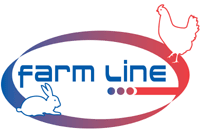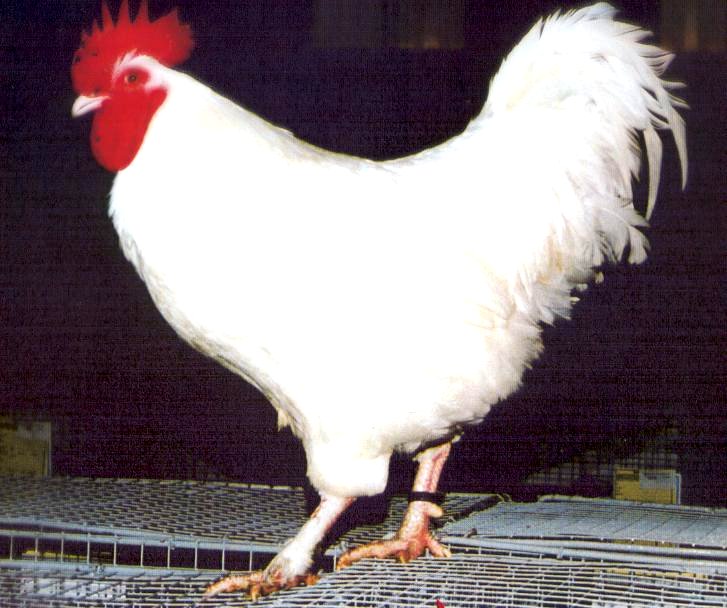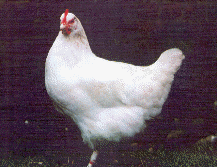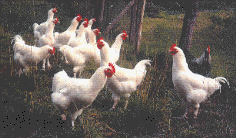

| Sponsors partenaires du MCF, informations et conditions par mail : CONTACT | |||||||
 |
|
 |
|||||
Photos sous licence Creative Commons
type http://creativecommons.org/licenses/by-sa/3.0/deed.fr
CC by sa
The white variety |
 |
|
|
The white Marans was very
widespread in the sixties, during its "half
industrial" time. Then it was abandonned in 1966 in
the favor of the colored poultries, and then it
progressively disappeared.
Considering the quasi-extinction situation of the white m in which we were, some years ago, we can speak of it as a ressurected variety … It's ressurection dated back to about 1990. Amongst the current existing varieties, we can reckon, without taking risk, that the white variety is, at the moment, the most fashionable among the following : plain-Black, Golden-cuckoo, ermined( light), Black-red , Brown-red, and Birchen. |
|
|
The plumage must be white on the whole body without any red, black or fawn feathers. The tarsus must also be white or pinkish like for the almost whole Marans variety.
However, in the white-colored cocks, the hackle, the shoulders, and the lancets can be straw-colored. It constitutes a coherent characteristic in the Marans breed.
Some explanations are here necessary and lead to develop below some essential notions of the white plumage genetics.
The genetic characteristics responsible for the white color of the hen feathers are not genes responsible for a particular color because all the feathers of our poultries are in reality consituted by a color combination like black, golden, wheat, fawn or others more complex ones are.
The white plumage is due to a genetic character which acts by widing off like an opaque veil, the existing plumage colors.
It is not either a matter of albinism cases which are clearly different at the genetic factor level (absence of all pigmentation including the eyes which are pink).
There are two main types of genes which are responsible for the white plumage of the hens :
Dominating white (I)
Since this characteristic is dominating, the more crossing of such a pure white subject with another colored subject theorically gives white plumage subjects. The initial color (black, fawn, wheat, cuckoo …) has been wide off or veiled except for some impureties which can soften by a steady selection of the white plumage on various generations and so we obtain a dominating white color in an homozygous state, i.e pure for this "dominating white" genetic characteristic.
The main breeds concerned with these characteristics are notably the "cou nu du Forez", the "leghorn blanche", the "Padoue blanche" and also perhaps some white Marans stocks.
Recessive white (c)
At its name indicates it, "recessive" this white color disappears in the first generation by a simple crossing with a subject of same color or other. For example a "gatinaise" (recessive white color) crossed with a black gaul cock gives young black subjects in first generation.
In other words, the recessive white color fades at the least-breed crossing.
The obtained colored subjects, if they have no white feathers, conserve none the less the recessive which genetic characteristic in the latent state in their genetic system (their genotype) so much that they are naturally able to pass it on th thei descendance by what we can call the atavistic return of the white genes (c).
So do the crossings between the colored subjects carrier of the (c) characteristic in the simple state (heterozygote) and consequently not expressed in the plumage, allow to obtain a proportion of about 25% of young white subjects ?
Indeed, by the hazard of the genetic combinations of such a crossing, two factors (c) can find themselves expressed in the double state for some descendants. They are homozygous for the (c) factor and so allow to express visually the recessive white plumage when it is pure again.
The considered subject genotype is written as for the white color (c/c) because the characteristic (c) is present in the double state in its chromosome.
The breeds which are concerned by the recessive white are more numerous : they are notably the white "Bresse", the "Gatinaise", the "white Marans", the "negre soie", "Dorking", the "Wyandottes"…
Nota bene : the chick down is either light yellow-colored or grayish-white (or smoked white).
The recessive white subjects can be made up some impureties scattered with grey, black or fawn color, but which usually can easily be "washed" but not totally with a view to the exhibitions.
They also have yellowish glints on the hackles, the back, the shoulders and the lancets of the cocks which appear after the adul moulted.
The white Marans plumage is, theorically provocked by the presence of the "recessive white genes". Consequently, it is usual to see appearing in the white cocks some strain colored glints on the hackles, the body underside and the lancets.
These glints seem to be intensified in the sun but we must admit that the real reason of their presence is a genetic reason because these yellow glints show the presence of coppery or fawn-colored genetic characteristics which are inadequally veiled by the "recessive white" genetic factor.
Moreover, we must add that at the precise time we are writing these lines, nothing proves that the "recessive white" factor has been the only characteristic responsible for the white plumage of the Marans breed.
Indeed, the "dominating white" which in theory tends to turn yellw could very well exist in some white Marans stocks considering the crossings carried out from the breed origin or even in the course of time…
The only efficient mean to eliminate in their tatality some yellow glints (if it turns out to become essential in the Marans) would consist in selecting some "dominating white" stocks (and not "recessive white" ones) in the pure state in a steady way (homozygotes) on nulerous generations.
The white Marans seems to be, at first sight, concerned only by the recessive white characteristicc. The presence of yellow glints has naturally imposed itself from the official standard origin and rightly so.
It would exist a possibility to wash off the fawn or ord residues by suppling, in the genotype, silver characteristics in order to eliminate the yellowish glints. In other words, it would be white subjects with a silver-cuckoo and especially a pure silver-black ( Birchen) background.
The egg shells of the present white Marans seem to have a less dark tonality in relation to the good coppery-black or other founder eggs.
It seems indisputable that the egg color selection will increase in the years to come notably by a new blood admixture of coppery black Marans or especially silver-black Marans. This use of the white variety should not be feared. We must remind you in this respect that a lot of wwhitemm are born of coppery-black founders which have contributed to its resurrection.
Photos sous licence Creative Commons
type http://creativecommons.org/licenses/by-sa/3.0/deed.fr
CC by sa
|
Problems and selection of the tarsus colour |
 |
White
Marans chicks
On the left : white tarsus On the right : blue-gray tarsus |
| If the white Marans must have
punkish white tarsus, it is still a long way from being
systematically the case today in our stocks because the (id+)
genes, which is responsible for the bluish feet, still
appear from time to time in the white Marans off-spring.
So they must be punkish-white and not slte-gray or bluish or even lead-gray like in the Bresse breed. Finally, another cuckoo responsible for the plumage color i.e the melanism (Ml) permits to have an influence on the (id+) gene in a complex way : it tends to explain the existance of a grey color variability of the tarsus from the light gray to the almost black. |
It's one the reasons why
the tarsus color of our black or coppery-black Marans are
not pinkinsk white, unlike all the other varieties (white
Marans, cuckoo, wheat, fawn) whose genes tend to inhibit
the melanism action.
It's clear that the improvment of the concerned stocks can't only be made by the elimination of the bluish or grey feet subjects or by the introduction of white Marans with pinkish white tarsus (preferably a cock since it is going to pass on its genes to its whole descendance). |
|
If it isn't already done in the present white Marans stocks it would be proper to introduce the dominating genetic (ID) characteristics responsible for the pinkish-white color of the tarsus as soon as the nearly totality of its stocks have gray feet. In the same time, a progressive eliminating selection of the blue-gray tarsus must be made.
It appears to us that this fault which persists especially in the white Marans must be able to settle without too many problems in the years to come since in the stocks, the correct white feet subjects exist incontestably.
However, we must notice that the breed crossings (which improve the egg quality) using some Brown-red stocks can occasionaly introduce again the darkening feet characteristic (id+) which is naturally linked to them.
The presence of white tarsus in the choosen stocks from at least one or the other of the considered founders proved to be all the more precious as it deals with the use of the Brown-red variety to improve the breed.
Photos sous licence Creative Commons
type http://creativecommons.org/licenses/by-sa/3.0/deed.fr
CC by sa
|
The white colored Marans selection |
 |
The exam of the qualities and faults of the present white stock whose selection is contempory allows us to define essentially the following three main lines for the white Marans improvment :
Concerning this last point, we must insist on the fact that a white Marans pen whose all breeding stock would have blue or lead-gray feet couldn't theorcally give birth to only one white feet subject anymore.
Indeed, the white feet (ID) characteristic which is dominating can't miraculously revive from breeding stock subjects with gray feet (because the genes are recessive).
Consequently, it seems today essential to use as far as possible a white foot cock.
For lack of anything else, when a cock has blue gray (or lead gray feet), it turns out to be inevitable to use white feet hens (even if it means to content ourselves if need be, of a more couple in which one of the two subjects show pinkisk-white tarsus.
Photos sous licence Creative Commons
type http://creativecommons.org/licenses/by-sa/3.0/deed.fr
CC by sa
|
The recommanded crossings with the white-colored Marans |
 |
The improvment of the plumage white color can't be perfect since the off variety crossings are made with Brown-red subjects in order to improve some priority characteristics (for example the eggs) which don't concern the purety of the white color.
The "wheat" and fawn varieties,due to their red and fawn pigment dominance, can only harm the plumage purity of the present white Marans which show, in this respect, a good quality level.
Today, it appears that we are far from being reduced to this extrem situation since the subjects with white tarsus are not few in the present white Marans livestock.
As for the method of the "off breed" crossings (for example with the white gatinaise breed) we must underline the fact that in the specific case of the Marans, this solution is to be categorically banned.
The admixture of a blood which is stranger to the breed doesn't fail to damage rapidly the genetic characteristic of the egg extra reddish-brown color, leading in this way to an egg selection work which is too long, fastidioous and even afterwards insurmontable in the White Marans variety. Only the "inbred" crossings are essential from the moment that the improvment can only be obtained by the indispensable supply of the genes wwhichare contained in the genotype of another Marans variety.
As the improvment of the white Marans egg shade imposes itself at the current time as being a pririty to whatever selection. It is especially advisable to carry out possible useful breedcrossings Marans stocks whose eggs are the most dark possible.
The use of the best Brown-red Marans (but especially the Birchen or Silver-black variety) (to produce extra reddish-brown eggs) seems to impose itself naturally in this good and especially for stocks which have already or almost settled the flaw of the blue-gray tarsus.
It is advisable to remind you in this respect that the color which is the more suitable to crossings as for the white plumage qualities of our poultries (in the case of an indispensable and "off variety" crossing) is parodaxically the pure plain-black color. But this color is unfortunately very rare in the Marans.
Anyway, such "inbred" variety crossings, if they proved to be essential in a more or less exceptional way, must follow a selection plan and a minimum of follow-up during several years.
We must remind you that in the same time, the setting up of farming pens for pure white Marans must systematically be carried out to ensure the present reservoir of the genetic white color of the Marans.
To conclude, we can admit that, for lack of the best improving crossings of the white Marans to date can be summed up by :
THE OFFICIAL VARIETIES OF THE CURRENT STANDARD
|
Silver-cuckoo Variety |
|
OTHER VARIETIES NOT APPROVED YET